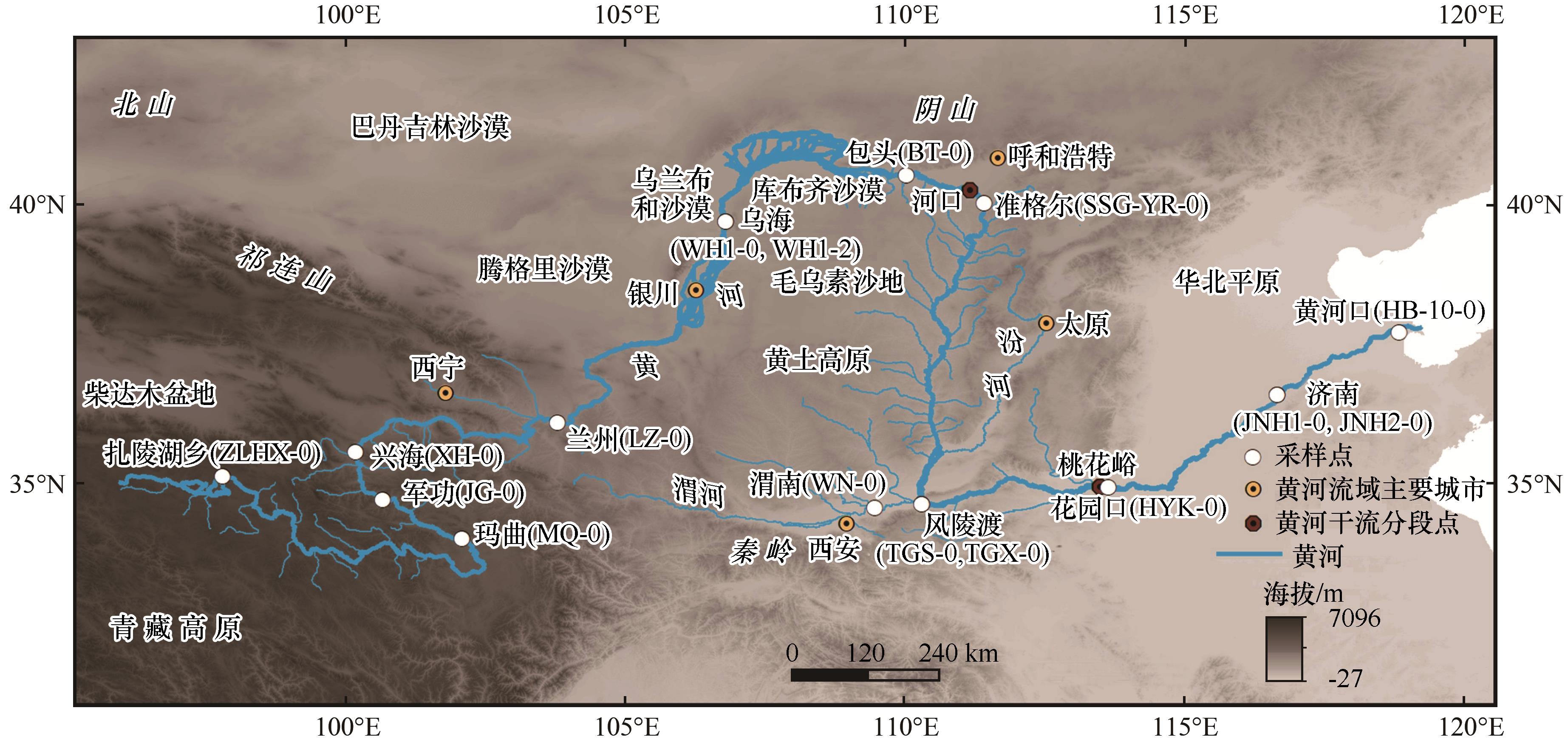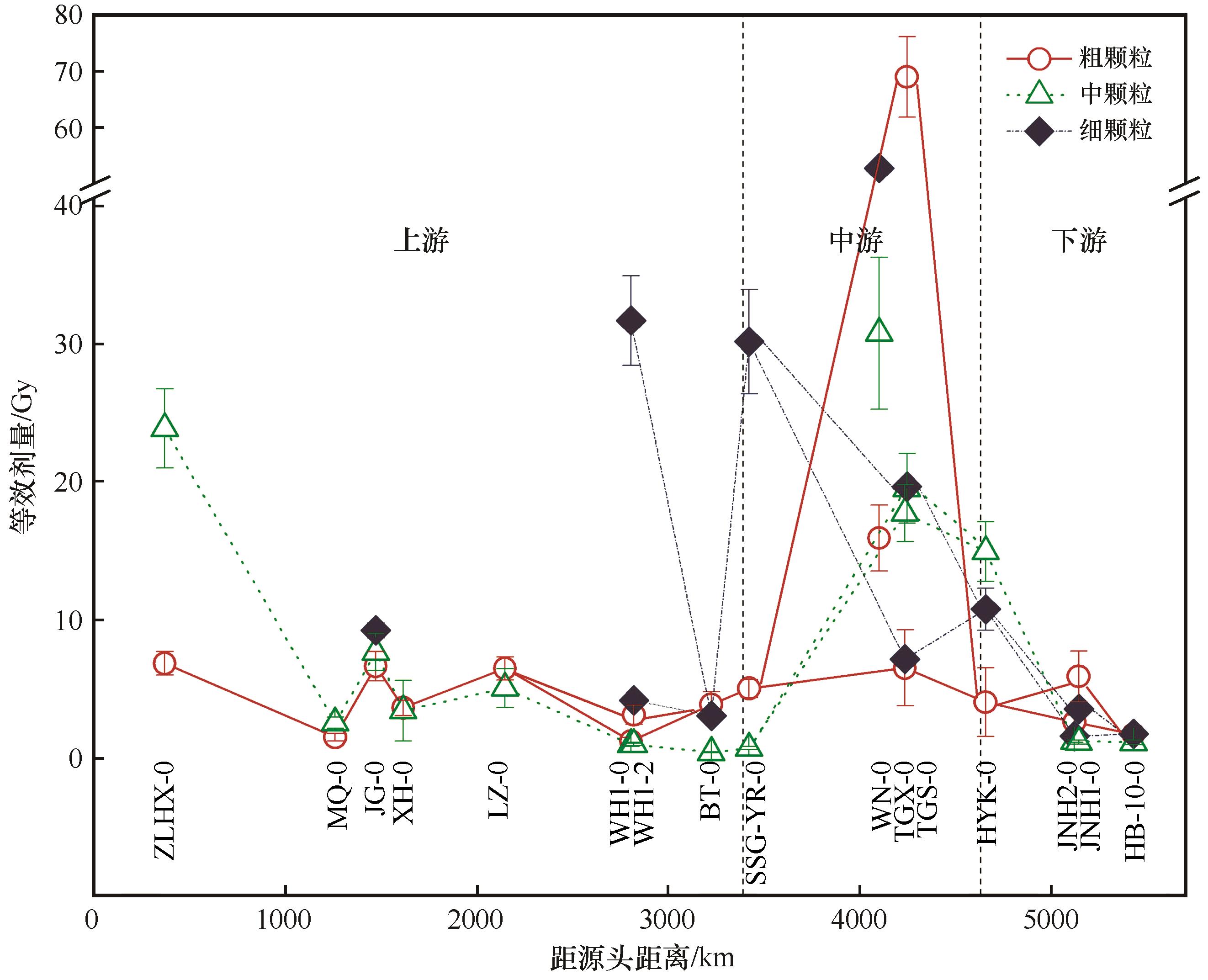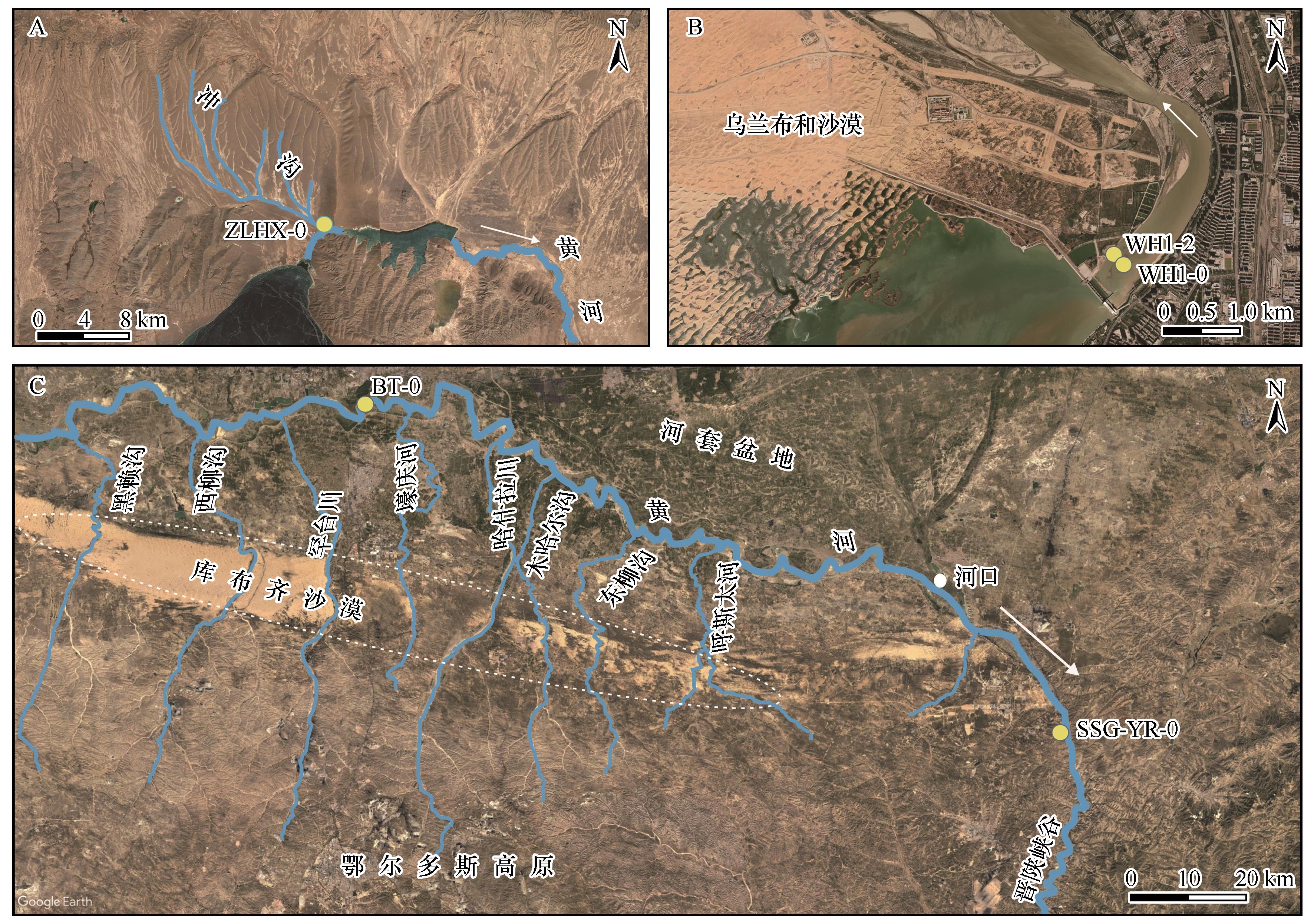
- CN 62-1070/P
- ISSN 1000-694X
- Bimonthly 1981

Journal of Desert Research ›› 2024, Vol. 44 ›› Issue (6): 26-36.DOI: 10.7522/j.issn.1000-694X.2024.00042
Previous Articles Next Articles
Xia Liu1,2( ), Jiangang Liu1, Ping An2, Qi An3, Changsheng Wang2, Yin Lv1,2, Dehua Xu2,4, Lupeng Yu2(
), Jiangang Liu1, Ping An2, Qi An3, Changsheng Wang2, Yin Lv1,2, Dehua Xu2,4, Lupeng Yu2( )
)
Received:2024-02-06
Revised:2024-03-13
Online:2024-11-20
Published:2024-12-06
Contact:
Lupeng Yu
CLC Number:
Xia Liu, Jiangang Liu, Ping An, Qi An, Changsheng Wang, Yin Lv, Dehua Xu, Lupeng Yu. Residual dose of quartz Optically Stimulated Luminescence signals in modern sediments of the Yellow River Basin[J]. Journal of Desert Research, 2024, 44(6): 26-36.
Add to citation manager EndNote|Ris|BibTeX
URL: http://www.desert.ac.cn/EN/10.7522/j.issn.1000-694X.2024.00042

Fig.1 Geomorphology and distribution of sampling sites in the Yellow River Basin (DEM data is downloaded from the Geospatial Data Cloud (http://www.gscloud.cn), and the data type is SRTMDEM with a resolution of 90 m)
| 样品编号 | 采样点 | 位置 | 海拔/m | 采样深度/cm | 采样环境 | 河段 | 平均粒径/μm | 沉积组分类型 |
|---|---|---|---|---|---|---|---|---|
| ZLHX-0 | 扎陵湖乡 | 35.11°N、97.78°E | 4 278 | 5 | 河漫滩 | 上游 | 501 | 粗砂、砾石 |
| MQ-0 | 玛曲 | 34.00°N、102.07°E | 3 479 | 5 | 河漫滩 | 上游 | — | 粗砂 |
| JG-0 | 军功 | 34.69°N、100.65°E | 3 079 | 5 | 河漫滩 | 上游 | 103 | 极细砂、细砂 |
| XH-0 | 兴海 | 35.55°N、100.16°E | 2 695 | 5 | 河漫滩 | 上游 | 320 | 中砂 |
| LZ-0 | 兰州 | 36.08°N、103.78°E | 1 519 | 5 | 河漫滩 | 上游 | 340 | 中砂 |
| WH1-0 | 乌海 | 39.68°N、106.79°E | 1 066 | 5 | 心滩 | 上游 | 336 | 中砂、粗砂、砾石 |
| WH1-2 | 乌海 | 39.68°N、106.79°E | 1 068 | 5 | 一级阶地 | 上游 | 67 | 粗粉砂、极细砂 |
| BT-0 | 包头 | 40.51°N、110.02°E | 1 003 | 5 | 河漫滩 | 上游 | 61 | 粗粉砂、极细砂 |
| SSG-YR-0 | 准格尔 | 40.00°N、111.42°E | 984 | 5 | 河漫滩 | 中游 | 95 | 极细砂、细砂 |
| WN-0 | 渭南 | 34.55°N、109.46°E | 349 | 5 | 边滩 | 渭河 | 34 | 粉砂 |
| TGS-0 | 风陵渡 | 34.62°N、110.30°E | 337 | 5 | 河漫滩 | 中游 | 39 | 粉砂 |
| TGX-0 | 风陵渡 | 34.62°N、110.30°E | 337 | 50 | 河漫滩 | 中游 | 38 | 粉砂 |
| HYK-0 | 花园口 | 34.92°N、113.64°E | 93 | 5 | 河漫滩 | 下游 | 29 | 粉砂 |
| JNH1-0 | 济南 | 36.57°N、116.67°E | 36 | 5 | 河漫滩 | 下游 | 71 | 粗粉砂、极细砂 |
| JNH2-0 | 济南 | 36.58°N、116.67°E | 33 | 5 | 河漫滩 | 下游 | 22 | 粉砂 |
| HB-10-0 | 黄河口 | 37.69°N、118.84°E | 1 | 5 | 潮滩 | 下游 | 42 | 粉砂 |
Table 1 Information of the sampling sites
| 样品编号 | 采样点 | 位置 | 海拔/m | 采样深度/cm | 采样环境 | 河段 | 平均粒径/μm | 沉积组分类型 |
|---|---|---|---|---|---|---|---|---|
| ZLHX-0 | 扎陵湖乡 | 35.11°N、97.78°E | 4 278 | 5 | 河漫滩 | 上游 | 501 | 粗砂、砾石 |
| MQ-0 | 玛曲 | 34.00°N、102.07°E | 3 479 | 5 | 河漫滩 | 上游 | — | 粗砂 |
| JG-0 | 军功 | 34.69°N、100.65°E | 3 079 | 5 | 河漫滩 | 上游 | 103 | 极细砂、细砂 |
| XH-0 | 兴海 | 35.55°N、100.16°E | 2 695 | 5 | 河漫滩 | 上游 | 320 | 中砂 |
| LZ-0 | 兰州 | 36.08°N、103.78°E | 1 519 | 5 | 河漫滩 | 上游 | 340 | 中砂 |
| WH1-0 | 乌海 | 39.68°N、106.79°E | 1 066 | 5 | 心滩 | 上游 | 336 | 中砂、粗砂、砾石 |
| WH1-2 | 乌海 | 39.68°N、106.79°E | 1 068 | 5 | 一级阶地 | 上游 | 67 | 粗粉砂、极细砂 |
| BT-0 | 包头 | 40.51°N、110.02°E | 1 003 | 5 | 河漫滩 | 上游 | 61 | 粗粉砂、极细砂 |
| SSG-YR-0 | 准格尔 | 40.00°N、111.42°E | 984 | 5 | 河漫滩 | 中游 | 95 | 极细砂、细砂 |
| WN-0 | 渭南 | 34.55°N、109.46°E | 349 | 5 | 边滩 | 渭河 | 34 | 粉砂 |
| TGS-0 | 风陵渡 | 34.62°N、110.30°E | 337 | 5 | 河漫滩 | 中游 | 39 | 粉砂 |
| TGX-0 | 风陵渡 | 34.62°N、110.30°E | 337 | 50 | 河漫滩 | 中游 | 38 | 粉砂 |
| HYK-0 | 花园口 | 34.92°N、113.64°E | 93 | 5 | 河漫滩 | 下游 | 29 | 粉砂 |
| JNH1-0 | 济南 | 36.57°N、116.67°E | 36 | 5 | 河漫滩 | 下游 | 71 | 粗粉砂、极细砂 |
| JNH2-0 | 济南 | 36.58°N、116.67°E | 33 | 5 | 河漫滩 | 下游 | 22 | 粉砂 |
| HB-10-0 | 黄河口 | 37.69°N、118.84°E | 1 | 5 | 潮滩 | 下游 | 42 | 粉砂 |
| 步骤 | 实验过程、条件 | 备注 |
|---|---|---|
| 1 | 自然信号或再生剂量Di (i=0, 1, 2, 3…) | — |
| 2 | 预热(260 ℃, 10 s) | — |
| 3 | 蓝光激发(125 ℃, 40 s) | Li |
| 4 | 辐照实验剂量Dt (100 s) | — |
| 5 | 预热(220 ℃, 10 s) | — |
| 6 | 蓝光激发(125 ℃, 40 s) | Ti |
| (步骤7~10用于IRSL检测) | — | |
| 7 | 辐照实验剂量D | — |
| 8 | 预热(220 ℃, 10 s) | — |
| 9 | 红外激发(50 ℃, 40 s) | |
| 10 | 蓝光激发(125 ℃, 40 s) | |
| 11 | 红外检测通过则重复步骤1~6 | — |
Table 2 The IRSL and Recuperation Checked SAR/SGC (IRC-SAR/SGC) procedure of quartz[7]
| 步骤 | 实验过程、条件 | 备注 |
|---|---|---|
| 1 | 自然信号或再生剂量Di (i=0, 1, 2, 3…) | — |
| 2 | 预热(260 ℃, 10 s) | — |
| 3 | 蓝光激发(125 ℃, 40 s) | Li |
| 4 | 辐照实验剂量Dt (100 s) | — |
| 5 | 预热(220 ℃, 10 s) | — |
| 6 | 蓝光激发(125 ℃, 40 s) | Ti |
| (步骤7~10用于IRSL检测) | — | |
| 7 | 辐照实验剂量D | — |
| 8 | 预热(220 ℃, 10 s) | — |
| 9 | 红外激发(50 ℃, 40 s) | |
| 10 | 蓝光激发(125 ℃, 40 s) | |
| 11 | 红外检测通过则重复步骤1~6 | — |

Fig.3 Decay curves, growth curves (dots) and SGC (black lines) of coarse-grained quartz samples (ZLHX-0 and LZ-0) (A is the sample signals mainly from the fast components; B is the sample affected by the slow components), and De distribution of LZ-0 dated with coarse-grained quartz (C, medium and dark gray bars present the results of FMM and the average dose model, respectively)
| 样品名 | 石英OSL信号De 值 /Gy | |||
|---|---|---|---|---|
| 粗颗粒 | 中颗粒 | 细颗粒 | ||
| 平均剂量模型 | MAM(σb=0.1)/FMM | 平均剂量模型 | 平均剂量 模型 | |
| ZLHX-0 | 6.9±0.9 | 4.3±0.6 | 23.9±2.9 | |
| MQ-0 | 1.5±0.3 | 0.8±0.2 | 2.6±0.4 | — |
| JG-0 | 6.7±1.1 | 5.4±0.3a | 7.7±1.4 | 9.3±0.5 |
| XH-0 | 3.7±0.6 | 3.5±0.3a | 3.5±2.2 | — |
| LZ-0 | 6.5±0.8 | 4.6±0.2a | 5.1±1.5 | — |
| WH1-0 | 1.2±0.3 | 0.5±0.1 | 1.0±0.2 | 31.7±3.2 |
| WH1-2 | 3.1±0.7 | 1.3±0.2 | 1.0±0.1 | 4.2±0.1 |
| BT-0 | 3.9±0.9 | 1.3±0.2 | 0.4±0.0 | 3.1±0.5 |
| SSG-YR-0 | 5.1±0.7 | 2.0±0.4 | 0.7±0.1 | 30.2±3.8 |
| WN-0 | 16.0±2.4 | 5.3±1.0 | 30.8±5.5 | 52.8±0.4 |
| TGS-0 | 69.0±7.2 | — | 19.5±2.5 | 19.7±0.1 |
| TGX-0 | 6.5±2.8 | — | 17.8±2.1 | 7.2±0.0 |
| HYK-0 | 4.1±2.5* | 0.7±0.1* | 15.0±2.16 | 10.8±1.5 |
| JNH1-0 | 5.9±1.8 | 1.7±0.3 | 1.2±0.2 | 3.6±0.0 |
| JNH2-0 | 2.6±0.5* | — | 1.2±0.1 | 1.6±0.0 |
| HB-10-0 | 1.7±0.3* | 0.4±0.1* | 1.2±0.2 | 1.8±0.1 |
Table 3 De values of different grain sizes quartz of luminescence signals
| 样品名 | 石英OSL信号De 值 /Gy | |||
|---|---|---|---|---|
| 粗颗粒 | 中颗粒 | 细颗粒 | ||
| 平均剂量模型 | MAM(σb=0.1)/FMM | 平均剂量模型 | 平均剂量 模型 | |
| ZLHX-0 | 6.9±0.9 | 4.3±0.6 | 23.9±2.9 | |
| MQ-0 | 1.5±0.3 | 0.8±0.2 | 2.6±0.4 | — |
| JG-0 | 6.7±1.1 | 5.4±0.3a | 7.7±1.4 | 9.3±0.5 |
| XH-0 | 3.7±0.6 | 3.5±0.3a | 3.5±2.2 | — |
| LZ-0 | 6.5±0.8 | 4.6±0.2a | 5.1±1.5 | — |
| WH1-0 | 1.2±0.3 | 0.5±0.1 | 1.0±0.2 | 31.7±3.2 |
| WH1-2 | 3.1±0.7 | 1.3±0.2 | 1.0±0.1 | 4.2±0.1 |
| BT-0 | 3.9±0.9 | 1.3±0.2 | 0.4±0.0 | 3.1±0.5 |
| SSG-YR-0 | 5.1±0.7 | 2.0±0.4 | 0.7±0.1 | 30.2±3.8 |
| WN-0 | 16.0±2.4 | 5.3±1.0 | 30.8±5.5 | 52.8±0.4 |
| TGS-0 | 69.0±7.2 | — | 19.5±2.5 | 19.7±0.1 |
| TGX-0 | 6.5±2.8 | — | 17.8±2.1 | 7.2±0.0 |
| HYK-0 | 4.1±2.5* | 0.7±0.1* | 15.0±2.16 | 10.8±1.5 |
| JNH1-0 | 5.9±1.8 | 1.7±0.3 | 1.2±0.2 | 3.6±0.0 |
| JNH2-0 | 2.6±0.5* | — | 1.2±0.1 | 1.6±0.0 |
| HB-10-0 | 1.7±0.3* | 0.4±0.1* | 1.2±0.2 | 1.8±0.1 |

Fig.4 Variation trend of De values for different grain sizes in quartz luminescence signals (The distance of WN-0 on the figure does not represent its actual distance and is only used for rendering De )

Fig.5 Overview of the surrounding environment of Gyaring Lake Township, Wuhai, Baotou, Jungar Banner (The satellite image are obtained from Google Earth)
| 1 | Knight J, Evans M.Luminescence dating,sediment analysis,and flood dynamics on the Sabie River,South Africa[J].Geomorphology,2018,319:1-14. |
| 2 | Machado M J, Medialdea A, Calle M,et al.Historical palaeohydrology and landscape resilience of a Mediterranean rambla (Castellón,NE Spain):floods and people[J].Quaternary Science Reviews,2017,171:182-198. |
| 3 | Godfrey-Smith D I, Huntley D J, Chen W H.Optical dating studies of quartz and feldspar sediment extracts[J].Quaternary Science Review,1988,7(3/4):373-380. |
| 4 | Singarayer J S, Bailey R M, Ward S,et al.Assessing the completeness of optical resetting of quartz OSL in the natural environment[J].Radiation Measurement,2005,40(1):13-25. |
| 5 | Hu G, Zhang J F, Qiu W L,et al.Residual OSL signals in modern fluvial sediments from the Yellow River (Huang He) and the implications for dating young sediments[J].Quaternary Geochronology,2010,5(2):187-193. |
| 6 | Colarossi D, Duller G A T, Roberts H M,et al.Comparison of paired quartz OSL and feldspar post-IR IRSL dose distributions in poorly bleached fluvial sediments from South Africa[J].Quaternary Geochronology,2015,30:233-238. |
| 7 | An P, Yu L P, Wang Y X,et al.Holocene incisions and flood activities of the Keriya River,NW margin of the Tibetan plateau[J].Journal of Asian Earth Sciences,2020,191:104224. |
| 8 | Yang X Y, Yu L P, Chang Q F,et al.Flood activity revealed millennial-scale climatic changes during the late Holocene in the Qaidam Basin,northeastern Tibetan Plateau[J].Quaternary International,2022,637:32-43. |
| 9 | Vandenberghe D, Derese C, Houbrechts G.Residual doses in recent alluvial sediments from the Ardenne (S Belgium)[J].Geochronometria,2007,28(1):1-8. |
| 10 | Olley J, Caitcheon G, Murray A.The distribution of apparent dose as determined by Optically Stimulated Luminescence in small aliquots of fluvial quartz:implications for dating young sediments[J].Quaternary Science Reviews,1998,17(11):1033-1040. |
| 11 | Zhao H, Liu Z, Song L,et al.OSL dating of flood sediments in the North China Plain[J].Quaternary Geochronology,2019,49:101-107. |
| 12 | Helena A.Residual OSL signals from modern Greenlandic River sediments[J].Geochronometria,2007,26:1-9. |
| 13 | Stokes S, Bray H E, Blum M D.Optical resetting in large drainage basins:tests of zeroing assumptions using single-aliquot procedures[J].Quaternary Science Reviews,2001,20(5/9):879-885. |
| 14 | Li F Q, Pan B T, Lai Z P.et al.Identifying the degree of luminescence signal bleaching in fluvial sediments from the Inner Mongolian reaches of the Yellow River[J].Geochronometria,2018,45(1):82-96. |
| 15 | Zhang J F, Qiu W L, Wang X Q,et al.Optical dating of a hyperconcentrated flow deposit on a Yellow River terrace in Hukou,Shaanxi,China[J].Quaternary Geochronology,2010,5(2-3):194-199. |
| 16 | Shen H Y, Yu L P, Zhang H M,et al.OSL and radiocarbon dating of flood deposits and its paleoclimatic and archaeological implications in the Yihe River Basin,East China[J].Quaternary Geochronology,2015,30:398-404. |
| 17 | Gray H J, Mahan S A.Variables and potential models for the bleaching of luminescence signals in fluvial environments[J].Quaternary International,2015,362:42-49. |
| 18 | Sanderson D C W, Bishop P, Stark M,et al.Luminescence dating of canal sediments from Angkor Borei,Mekong Delta,Southern Cambodia[J].Quaternary Geochronology,2007,2(1/4):322-329. |
| 19 | Thompson J A, Chen J, Yang H L,et al.Coarse-versus fine-grain quartz OSL and cosmogenic 10Be dating of deformed fluvial terraces on the northeast Pamir margin,northwest China[J].Quaternary Geochronology,2018,46:1-15. |
| 20 | Buylaert J P, Thiel C, Murray A S,et al.IRSL and post-IR IRSL residual doses recorded in modern dust samples from the Chinese Loess Plateau[J].Geochronometria,2011,38:432-444. |
| 21 | Li G Q, Dong G H, Wen L J,et al.Overbank flooding and human occupation of the Shalongka site in the Upper Yellow River Valley,northeast Tibet Plateau in relation to climate change since the last deglaciation[J].Quaternary Research,2014,8(2):354-365. |
| 22 | Liu J G, Fan H Y, An P,et al.Mega-lake formation in the eastern Hetao Basin,China,during marine isotope stages 7 and 5:a comparison of quartz and feldspar luminescence dating[J].Frontiers in Earth Science,2023,11:1177629. |
| 23 | 李兆宁,刘进峰,崔富荣,等.黄河悬移质多种光释光信号的顺流变化特征及对河流搬运过程和测年应用的启示[J].第四纪研究,2022,42(5):1388-1400. |
| 24 | 许炯心.黄河河流地貌过程[M].北京:科学出版社,2012:1-139. |
| 25 | 水利部.中国河流泥沙公报(2000-2009年)[M].北京:中国水利水电出版社,2009. |
| 26 | 赵慧霞,卓莹莹,刘厚凤.1961-2019年黄河流域降水量时空变化特征分析[J].人民黄河,2022,44(3):26-31. |
| 27 | 刘增琦,于禄鹏,安萍,等.柴达木盆地夏日哈河中游古洪水沉积物的粒度特征[J].临沂大学学报,2019,41(6):76-86. |
| 28 | Udden J A.Mechanical composition of clastic sediment[J].Geological Society of America Bulletin,1914,25(1):655-744. |
| 29 | Zhang J F, Fan C F, Wang H,et al.Chronology of an oyster reef on the coast of Bohai Bay,China:constraints from optical dating using different luminescence signals from fine quartz and polymineral fine grains of coastal sediments[J].Quaternary Geochronology,2007,2(1/4):71-76. |
| 30 | 于禄鹏.末次间冰期以来柴达木盆地风成沉积释光年代学及其环境意义[D].西宁:中国科学院青海盐湖研究所,2012. |
| 31 | Murray A S, Wintle A G.Luminescence dating of quartz using an improved single-aliquot regenerative-dose protocol[J].Radiation Measurements,2000,32(1):57-73. |
| 32 | Murray A S, Wintle A G.The single aliquot regenerative dose protocol:potential for improvements in reliability[J].Radiation Measurements,2003,37(4/5):377-381. |
| 33 | Roberts H M, Duller G A T.Standardised growth curves for optical dating of sediment using multiple-grain aliquots[J].Radiation Measurements,2004,38(2):241-252. |
| 34 | Wintle A G, Murray A S.A review of quartz Optically Stimulated Luminescence characteristics and their relevance in single-aliquot regeneration dating protocols[J].Radiation Measurements,2006,41(4):369-391. |
| 35 | Cunningham A C, Wallinga J.Optically Stimulated Luminescence dating of young quartz using the fast component[J].Radiation Measurements,2009,44(5/6):423-428. |
| 36 | Cunningham A C, Wallinga J.Selection of integration time intervals for quartz OSL decay curves[J].Quaternary Geochronology,2010,5(6):657-666. |
| 37 | Guérin G, Christophe C, Philippe A,et al.Absorbed dose,equivalent dose,measured dose rates,and implications for OSL age estimates:introducing the Average Dose Model[J].Quaternary Geochronology,2017,41:163-173. |
| 38 | Galbraith R F, Roberts R G, Laslett G M,et al.Optical dating of single and multiple grains of quartz from Jinmium rock shelter,Northern Australia:part I,experimental design and statistical models[J].Archaeometry,1999,41(2):339-364. |
| 39 | Galbraith R F, Green P F.Estimating the component ages in a finite mixture[J].Nuclear Tracks and Radiation Measurements,1990,17(3):197-206. |
| 40 | Fuchs M, Straub J, Zoller L.Residual luminescence signals of recent river flood sediments:a comparison between quartz and feldspar of fine-and coarse-grain sediments[J].Ancient TL,2005,23(1):25-30. |
| 41 | Pan B T, Pang H L, Zhang D,et al.Sediment grain-size characteristics and its source implication in the Ningxia-Inner Mongolia sections on the upper reaches of the Yellow River[J].Geomorphology,2015,246:255-262. |
| 42 | 刘东生.黄河中游黄土[M].北京:科学出版社,1964:180-185. |
| 43 | Xu J X.The wind-water two-phase erosion and sediment-producing processes in the middle Yellow River basin,China[J].Science in China Series D:Earth Sciences,2000,43:176-186. |
| 44 | 林旭,刘海金,刘静,等.黄河流域碎屑钾长石Pb同位素物源示踪[J].地震地质,2022,44(4):944-960. |
| 45 | 陈垚.黄河泥沙沉积物演化特征及物源示踪[D].西安:长安大学,2020. |
| 46 | 王兆印,王文龙,田世民.黄河流域泥沙矿物成分与分布规律[J].泥沙研究,2007(5):1-8. |
| 47 | Nie J S, Stevens T, Rittner M,et al.Loess Plateau storage of northeastern Tibetan Plateau-derived Yellow River sediment[J].Nature Communications,2015,6(1):1-10. |
| 48 | 赵文林.黄河泥沙[M].郑州:黄河水利出版社,1996:35-165,507. |
| 49 | Ta W Q, Wang H B, Jia X P.Downstream fining in contrasting reaches of the sand bedded Yellow River[J].Hydrological Processes,2011,25(24):3693-3700. |
| 50 | Rittenour T M.Luminescence dating of fluvial deposits:applications to geomorphic,palaeoseismic and archaeological research[J].Boreas,2008,37(4):613-635. |
| 51 | Ditlefsen C.Bleaching of K-feldspars in turbid water suspensions:a comparison of photoluminescence and thermoluminescence signals[J].Quaternary Science Reviews,1992,11(1/2):33-38. |
| 52 | Yang G S, Liu Y X, Shi P J.Estimation of the aeolian sand entering the Yellow River[J].Chinese Science Bulletin,1987,13(13):1017-1021. |
| 53 | 杨根生,拓万全,戴丰年,等.风沙对黄河内蒙古河段河道泥沙淤积的影响[J].中国沙漠,2003,23(2):152-159. |
| 54 | Ta W Q, Xiao H L, Dong Z B.Long-term morphodynamic changes of a desert reach of the Yellow River following upstream large reservoirs' operation[J].Geomorphology,2008,97(3/4):249-259. |
| 55 | 杨根生.黄河石嘴山-河口镇段河道淤积泥沙来源分析及治理对策[M].北京:海洋出版社,2002. |
| 56 | 唐政洪,蔡强国,李忠武,等.内蒙古砒砂岩地区风蚀、水蚀及重力侵蚀交互作用研究[J].水土保持学报,2001,15(2):25-29. |
| 57 | Gray H J, Tucker G E, Mahan S A,et al.On extracting sediment transport information from measurements of luminescence in river sediment[J].Journal of Geophysical Research:Earth Surface,2017,122(3):654-677. |
| 58 | McGuire C, Rhodes E J.Determining fluvial sediment virtual velocity on the Mojave River using K-feldspar IRSL:initial assessment[J].Quaternary International,2015,362:124-131. |
| 59 | Gliganic L A, Cohen T J, Meyer M,et al.Variations in luminescence properties of quartz and feldspar from modern fluvial sediments in three rivers[J].Quaternary Geochronology,2017,41:70-82. |
| Viewed | ||||||
|
Full text |
|
|||||
|
Abstract |
|
|||||
©2018Journal of Desert Research
Tel:0931-8267545
Email:caiedit@lzb.ac.cn;desert@lzb.ac.cn
Support:Magtech